It was Wednesday, December 30, 1903, the end of a festive Christmas week. The weather in Chicago was fair, temps in the low teens, a hint of snow flurries forecast for the evening and heavier snow later in the week.
Annie Bergch, her husband Arthur Sr. and their 11 year old son Arthur James left their five room, two bedroom three story brownstone built 1895 at 4926 S. Champlain. They made their way seven miles to downtown’s vibrant theatre district, eager to see the 2PM afternoon matinee of Mr. Bluebeard.
 The Bergch family was just three of as many as 2200 theatregoers, mostly women and children, arriving at the Iroquois Theatre at 24–28 West Randolph Street, between State Street and Dearborn Street. There were only 1,602 seats in this new theatre so several hundred had standing room only tickets causing people to be four-deep behind the last row of seats and many others sitting in the aisles..
The Bergch family was just three of as many as 2200 theatregoers, mostly women and children, arriving at the Iroquois Theatre at 24–28 West Randolph Street, between State Street and Dearborn Street. There were only 1,602 seats in this new theatre so several hundred had standing room only tickets causing people to be four-deep behind the last row of seats and many others sitting in the aisles..
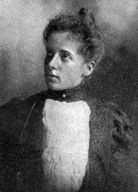
Annie Hedges Bergch was 32 years old, the daughter of James and Mary Hedges. She was born August 21 1871 in Canada. Annie married Arthur Bergch, on November 17, 1891 in Chicago, IL. He was engaged in the wholesale tobacco business.
 Their son Arthur James was born oct 22 1892 and their youngest Edward George born June 28 1899. Edward did not go to the theatre probably because of his young age. He would lose his mother on this day, then be raised by his grandparents and later marry.
Their son Arthur James was born oct 22 1892 and their youngest Edward George born June 28 1899. Edward did not go to the theatre probably because of his young age. He would lose his mother on this day, then be raised by his grandparents and later marry.
Annie, her son Arthur and some 600 others would die that fateful afternoon, most of them to the toxic fumes and smoke in the worst theatre fire in the United States. And it was the worst disaster in Chicago’s history, inflicting a greater death toll than the Great Chicago Fire of 1871, in which about 250 died.
How could this possibly happen in a city so aware of the dangers of fire?
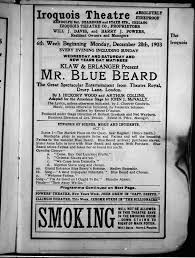 Tragedy is almost always the result of multiple factors and errors. The Iroquois was no exception. Of 30 exits, 27 had been locked and few of them were marked. Many exits were concealed by flammable draperies.. Stairways were blocked with accordion style steel gates to prevent people with inexpensive tickets from moving to better parts of the theater. There were faulty unfinished fire escapes, no alarms, no sprinklers, no telephones, or water connections. There was no fire alarm box. Skylights on the roof of the stage, intended to open automatically during a fire and allow smoke and heat to escape, were fastened closed. The asbestos curtain at the Iroquois not only failed to lower but also proved to be both weak and flammable. Icy fire escapes, not yet finished on the north wall led to at over 100 deaths.
Tragedy is almost always the result of multiple factors and errors. The Iroquois was no exception. Of 30 exits, 27 had been locked and few of them were marked. Many exits were concealed by flammable draperies.. Stairways were blocked with accordion style steel gates to prevent people with inexpensive tickets from moving to better parts of the theater. There were faulty unfinished fire escapes, no alarms, no sprinklers, no telephones, or water connections. There was no fire alarm box. Skylights on the roof of the stage, intended to open automatically during a fire and allow smoke and heat to escape, were fastened closed. The asbestos curtain at the Iroquois not only failed to lower but also proved to be both weak and flammable. Icy fire escapes, not yet finished on the north wall led to at over 100 deaths.
 The Iroquois theatre was designed by noted architect Benjamin Marshall, and was hastily dedicated on November 23 1903 with the play “Mr. Bluebeard”. The theatre was touted as “one of the finest in the country” and “absolutely fireproof”. It was lavishly decorated with fine marble staircases, elegant red velvet draperies, oriental wall covering and much mahogany but flammable woodwork.
The Iroquois theatre was designed by noted architect Benjamin Marshall, and was hastily dedicated on November 23 1903 with the play “Mr. Bluebeard”. The theatre was touted as “one of the finest in the country” and “absolutely fireproof”. It was lavishly decorated with fine marble staircases, elegant red velvet draperies, oriental wall covering and much mahogany but flammable woodwork. The main floor, known as the orchestra or parquet, had approximately 700 seats on the same level as the foyer and Grand Stair Hall. The second level, the dress circle or first balcony, had more than 400 seats. The third level, the gallery, had about 500 seats. There were four boxes on the first level and two above.
The main floor, known as the orchestra or parquet, had approximately 700 seats on the same level as the foyer and Grand Stair Hall. The second level, the dress circle or first balcony, had more than 400 seats. The third level, the gallery, had about 500 seats. There were four boxes on the first level and two above.

A few minutes after 3 PM, during the second act of the matinée, a calcium light stand casting blue light onto the stage to simulate a night scene short circuited and ignited a drop curtain. The band was playing “By the Pale Moonlight”. Two stagehands tried to extinguish it, but the flames were already too large for them to control. The fire spread quickly to the flammable scenery and stage props.Then he fire fed from a blast of icy air from open doors backstage enveloped the rest of the theatre, especially the balconies.
 At 3:32 PM the first fire alarm was sounded received by the closest firehouse, Engine 13, only 200 feet away arrived within minutes after the alarm was received. Michael J. Corrigan of Engine 13 one of the first on the scene who later became the Fire Commissioner. Truck 9 was the first hook and ladder to arrive. The first arriving engine immediately sounded an extra alarm at 3:33 PM and soon dozens of fire companies and police responded to rescue the injured and carry out the hundreds of dead. The fire itself was extinguished within thirty minutes holding the building damage to a minimum.
At 3:32 PM the first fire alarm was sounded received by the closest firehouse, Engine 13, only 200 feet away arrived within minutes after the alarm was received. Michael J. Corrigan of Engine 13 one of the first on the scene who later became the Fire Commissioner. Truck 9 was the first hook and ladder to arrive. The first arriving engine immediately sounded an extra alarm at 3:33 PM and soon dozens of fire companies and police responded to rescue the injured and carry out the hundreds of dead. The fire itself was extinguished within thirty minutes holding the building damage to a minimum.
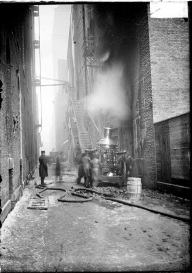 The dead and injured were carried out and taken into stores and restaurants. These businesses also provided blankets, supplies for the victims. Tablecloths were used to cover the dead.
The dead and injured were carried out and taken into stores and restaurants. These businesses also provided blankets, supplies for the victims. Tablecloths were used to cover the dead.
I will leave the worst of the fire details to the hundreds of other accounts and several books on the fire. But first, we must bury those who perished.

 Annie and her son Arthur’s funeral was held in their apartment on Champlain on January 4th 1904. They were then taken to Oakwoods Cemetery where both were buried in Plot Section J, Division 1, lot 853.
Annie and her son Arthur’s funeral was held in their apartment on Champlain on January 4th 1904. They were then taken to Oakwoods Cemetery where both were buried in Plot Section J, Division 1, lot 853.
After the fire, Annie’s husband Arthur Sr. who was injured in the fire, remarried in August of 1905 and relocated to Milwaukee Wisconsin.
 There were hundreds of other funerals in those dreadful days after the fire.
There were hundreds of other funerals in those dreadful days after the fire. Hundreds of obituaries told the grim story. There were four dead from one house alone.
Hundreds of obituaries told the grim story. There were four dead from one house alone.
Eva Tuttle Pond age 47, her children Raymond age 14 and Helen age 7 as well as Grace Tuttle age 35, sister of Eva, a Chicago Public School teacher for 18 years, all perished. They were buried in Beloit Wisconsin.  At Furth Funeral home, Rabbi Stolz officiated for five funerals for burial at Jewish Waldheim.
At Furth Funeral home, Rabbi Stolz officiated for five funerals for burial at Jewish Waldheim.
On Friday January 1, 1904 in heavy snow, wind, and cold there were 89 burials. The next day, Saturday, there were 197 burials and on Sunday an additional 256 were either buried or shipped out. Hearses and carriages were scarce and had to be brought in from outlying areas and suburbs. White horse drawn hearses were for children, black for adults. Undertakers were overwhelmed. Bentley undertakers at 238 Lincoln had 30 funerals alone. Gravediggers were also overworked. Graves were dug during the night by lantern. Coffins, especially children’s coffins were scarce, and had to be hastily ordered. Many funerals were planned early in the morning, so a second could be held in the afternoon. Instead of one hearse for a single funeral, there were two, three, or four. So many families lost children, brothers and sisters.
The theatre victims were buried in over a dozen of the Chicago area cemeteries including the largest cemeteries Rosehill, at least 50 to Graceland, and many to Oakwoods. Catholics went to St. Boniface, Mt. Carmel and over 40 to Calvary in Evanston. Others went to Mt. Olive, some 30 to Forest Home, many to Jewish Waldheim, Mt. Hope, Elmwood in River Grove and others. In 1908, Montrose Cemetery erected a memorial monument to the victims.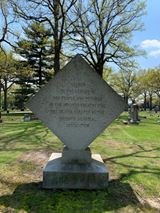
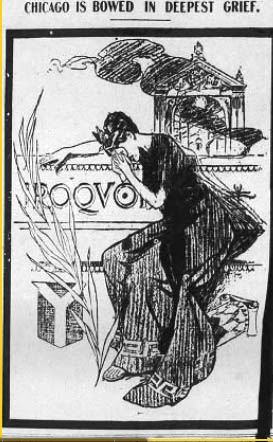 If any good came out of this awful fire, the disaster caused many changes in building design and the fire laws that protect us today. Building codes were quickly adopted regarding location of exits, width of aisles, location of fire escapes. All theater exits had to be clearly marked and illuminated. Exit doors now could only be opened only outward (although that was not a primary cause of this fire). Panic bars were adopted for doors. The mayor issued an edict that 36 theatres be shut down out of safety concerns and ordered all to be retrofitted. Theatres in other cities and even Europe did the same.
If any good came out of this awful fire, the disaster caused many changes in building design and the fire laws that protect us today. Building codes were quickly adopted regarding location of exits, width of aisles, location of fire escapes. All theater exits had to be clearly marked and illuminated. Exit doors now could only be opened only outward (although that was not a primary cause of this fire). Panic bars were adopted for doors. The mayor issued an edict that 36 theatres be shut down out of safety concerns and ordered all to be retrofitted. Theatres in other cities and even Europe did the same.
Even with public outrage, nobody was found guilty. Most charges including against Mayor Carter Harrison, Jr. for inadequacies in the city’s building and safety ordinances were dismissed. Building inspectors had overlooked violations in exchange for free theatre tickets. Only the construction company settled some lawsuits for $750 each.
 The Iroquois was repaired, rebuilt and reopened less than a year later, renamed as the Hyde and Behman’s Music Hall presenting vaudeville entertainment. In 1905, the theatre then became the Colonial Theatre and lasted 19 years.
The Iroquois was repaired, rebuilt and reopened less than a year later, renamed as the Hyde and Behman’s Music Hall presenting vaudeville entertainment. In 1905, the theatre then became the Colonial Theatre and lasted 19 years.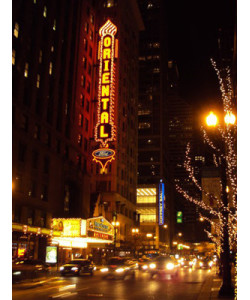
The Colonial was torn down in May 1924 and replaced by the United Masonic Temple building housing the grand Oriental Theater in 1926. On November 13, 2018, the Oriental was renamed to James M. Nederlander Theatre.
So on this day, we remember all who were injured and died in this horrible fire. May they all rest in peace. And we thank all first responders who respond to our needs each day.
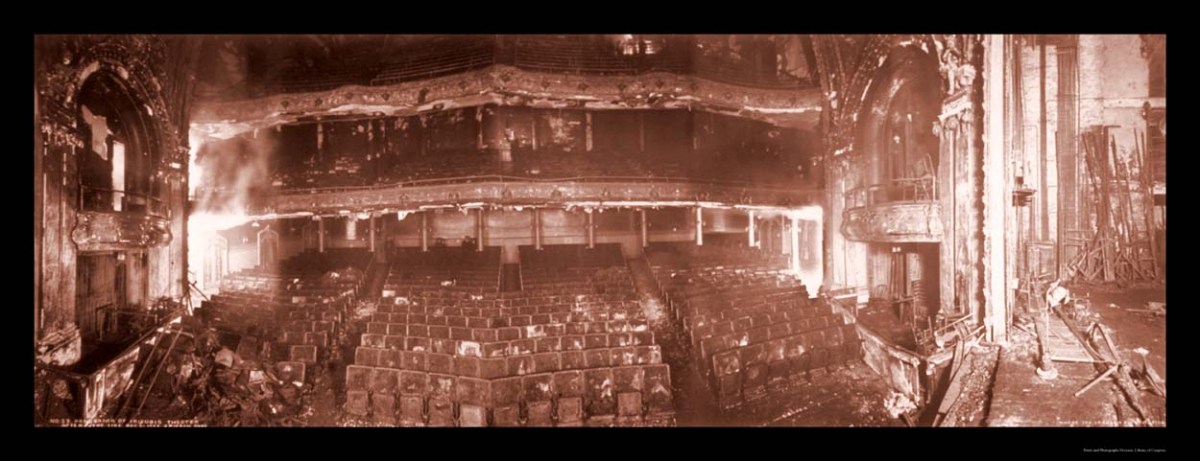


The rest of the story can’t be found. It’s very interesting so far.
LikeLike
so sorry. The post was released by accident. The whole story is now up! Best regards Barry Fleig
LikeLike
There is a book on it.
LikeLike
Very interesting and very well written. Such tragedies have been discovered by Barry, and make the history of them new and surprising to learn about.
LikeLike
Thanks!! your comment makes me happy!
LikeLike
I have read that some were able to escape by using an unfinished fire escape that opened into an alley. Does this alley still exist? I am near there once a week and would like to visit it. Thanks.
LikeLike
I’ve read a contemporary account. The book contained a listing of the victims and toner addresses. Perusing the list, you see that every neighborhood, maybe even every street in town was home to someone who died in the fire.
LikeLike